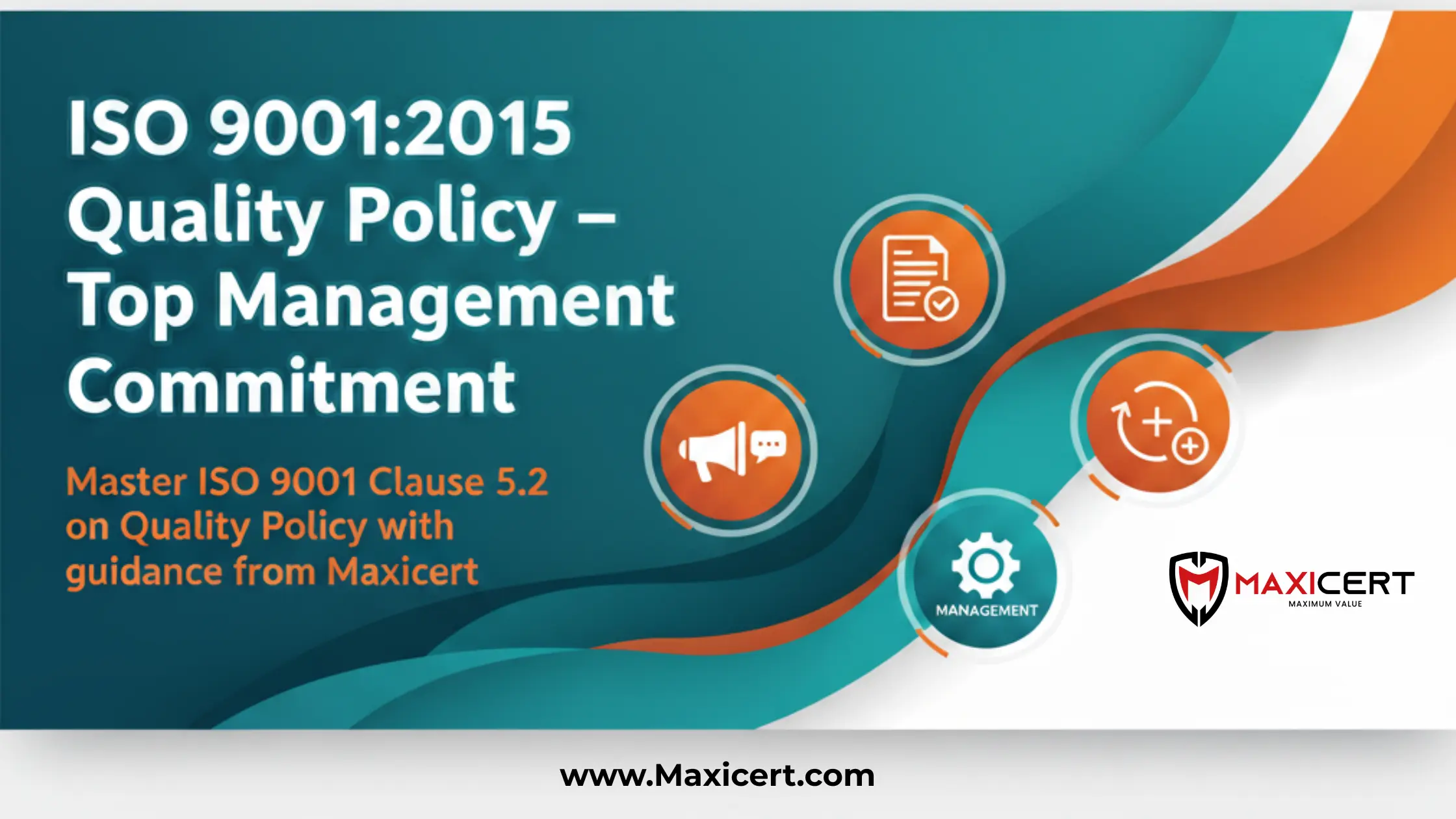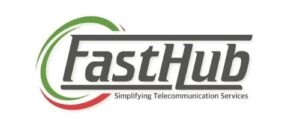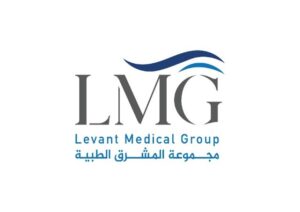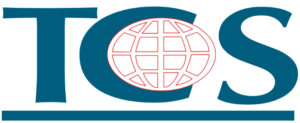ISO 9001:2015 Quality Policy – How to Create and Communicate It
Introduction
Master ISO 9001:2015 Clause 5.2 on Quality Policy with guidance from Maxicert. This section explains how top management must establish and communicate a policy that aligns with the organization’s goals. Learn how a strong quality policy provides a framework for setting objectives and committing to continual improvement, ensuring it’s understood and applied by all—with Maxicert helping organizations implement it effectively.

5.2 Policy
Unlocking business excellence? ISO 9001:2015 Clause 5.2 on Quality Policy is your key. Learn how top management can craft a powerful policy that aligns with strategic goals, drives continual improvement, and sets a clear framework for quality objectives. This simple guide helps you understand and implement this vital standard for business success.
5.2.1 Establishing the Quality Policy
Top management shall establish, implement and maintain a quality policy that:
- is appropriate to the purpose and context of the organization and supports its strategic direction
- provides a framework for setting quality objectives
- includes a commitment to satisfy applicable requirements
- includes a commitment to continual improvement of the quality management system
5.2.2 Communicating the Quality Policy
The quality policy shall:
a) be available and be maintained as documented information,
b) be communicated, understood and applied within the organization,
c) be available to relevant interested parties, as appropriate.
Top management should use the quality policy as a means of leading the organization toward improvement of its performance.
An organization’s quality policy should be an equal and consistent part of the organization’s overall policies and strategy.
- The intent of the clause on Quality Policy is to specify the high-level organizational commitments required of ISO 9001, taking into account the organization’s purpose. It is used to frame the quality objectives that the organization sets for itself.
- Documentation of the policy is created and controlled in accordance with the requirements of documented information (7.5).
ISO 9001:2015 Clause Guide Panel
- Clause 1
- Clause 2
- Clause 3
- Clause 4 – Sub-clause 1
- Clause 4 – Sub-clause 2
- Clause 5 – Sub-clause 1
- Clause 5 – Sub-clause 2
- Clause 5 – Sub-clause 3
- Clause 6 – Sub-clause 1
- Clause 6 – Sub-clause 2
- Clause 7 – Sub-clause 1
- Clause 7 – Sub-clause 2
- Clause 7 – Sub-clause 3
- Clause 7 – Sub-clause 4
- Clause 8 – Sub-clause 1
- Clause 8 – Sub-clause 2
- Clause 8 – Sub-clause 3
- Clause 8 – Sub-clause 4
- Clause 8 – Sub-clause 5
- Clause 8 – Sub-clause 6
- Clause 8 – Sub-clause 7
- Clause 8 – Sub-clause 8
- Clause 8 – Sub-clause 9
- Clause 8 – Sub-clause 10
- Clause 8 – Sub-clause 11
- Clause 8 – Sub-clause 12
- Clause 9 – Sub-clause 1
- Clause 9 – Sub-clause 2
- Clause 9 – Sub-clause 3
- Clause 9 – Sub-clause 4
- Clause 10
The Quality Policy is communicated internally in accordance with the requirements of the Communication clause (7.4). It also should be made available to other interested parties.
While the quality policy is expected to contain a commitment to satisfy applicable requirements, in particular laws and regulations, it is understood that even the most effective QMS will not guarantee full compliance at any particular point in time. Under such circumstances, it should not be considered out of conformance so long as the QMS results in the prompt detection and corrective action of the system deficiencies that contributed to the instance(s) of noncompliance.
Quality policy is a document (documented information), which should be developed with the practical participation of top management (as follows from Clause 5.1.1). It may consist of one document, may be contained in several documents or form part of other documents. Like any other documented information, it may be in any form, in any medium and from any source. For example, the quality policy can be:
Quality Policy contains the intentions of the organization and direction of its activities related to quality. It may be linked to the vision and mission of the organization. To develop a quality policy, quality management principles can be used, for example, statements on the intentions and directions of development of the organization on customer focus, process approach, engagement of people, etc.
Clause 5.2 of ISO 9001:2015 is composed of two subclauses, the first of which (5.2.1) contains the requirements for the content of the quality policy:
- The content of the policy should comply with the purpose of the organization and should take into account the internal and external factors, which during the implementation of the requirements of section 4.1 were considered relevant to the quality management system.
- The quality policy directions, content and structure should form a logical basis for the quality objectives content. For example, the structure in which the list of quality objectives are developed in accordance with the list of directions of development outlined in the quality policy.
- The quality policy should include a specific commitment of the top management to meet the requirements that have been considered related to the quality management system during the implementation of the requirements of clause 4.2. This creates a documented evidence of this commitment that should be used to form personnel awareness of the importance of these requirements.
- The quality policy should include a specific statement of the top management commitment to continual improvement of the quality management system. This creates a documented evidence of this commitment that should be used to form personnel awareness of the importance of these improvements. The clause 5.2.1 c)
- and d) does not include any requirement about the words that an Organization shall use to express the commitment above. Therefore, an Organization may use terms not necessarily identical to the ones cited in the clause. Nevertheless, in order to satisfy the requirement. the statement of the quality policy needs to expressly address a commitment to satisfy the applicable requirements, and a commitment to continual improvement of the QMS
- The Quality Objectives should be traceable to the Quality Policy; therefore, the Quality Policy should provide a clear framework for setting, deploying and reviewing the Quality Objectives
- The Quality Policy also needs to be reviewed from time to time to determine if it is still appropriate for the Organization. Things to consider would be if the policy is still relevant to the changes in external and internal issues that are relevant to the quality management system, including its strategic direction: This could be carried out during the management review required in 9.3.1
The second subclause (5.2.2) contains requirements for the control and usage of the quality policy:
- The quality policy should be in the form of documented information and, accordingly, be controlled in accordance with the requirements stated in section 7.5 of ISO 9001:2015.
- A documented information could be for example, a publicly displayed copy of the quality policy signed by the company’s owner. Another method is to present the quality policy at meetings and retain records of the meetings.
- The main intention of the quality policy is to inform all personnel about the directions of development of the organization and commitments related to requirements compliance and improvement. That is why the organization should make constant efforts to ensure awareness and application of the quality policy throughout the organization.
- If the organization decides that the communication of its quality policy to certain interested parties can benefit the organization, it should develop and implement actions to communicate the quality policy for those parties.
- Communicating the Quality Policy to the external providers or to the partners could be necessary as a condition to ensure the capacity of the Organization to provide products and services that fulfill the requirement and to achieve and improve the customer satisfaction.
- Communicating the Quality Policy to the Customer and to other relevant interested parties in the context of the Organization, such as the Community, could be a basis for the involvement of these parties in the Quality Management System, as necessary to obtain and sustain the long term success of the Organization.
- The decision of communicating, or not, the Quality Policy to the interested parties, should be supported by a rationale and by a risk based approach, in order to ensure its appropriateness.
The quality policy also needs to be reviewed from time to time to determine if it is still appropriate for your organization. Things to consider would be if the policy is still relevant to the purpose of the organization.
For example, if the organization has increased its scope to include design as part of its product offerings in order to increase market share, the quality policy might need to be revised to reflect that change. This could be carried out during the management review required in 5.6
Conclusion
Clause 5.2 of ISO 9001:2015 highlights the importance of establishing a clear, relevant, and actionable quality policy that aligns with the organization’s purpose and strategy. With Maxicert’s expertise, top management can ensure active participation, proper documentation, and effective communication of the policy. This creates a strong foundation for setting objectives, ensuring compliance, and driving continual improvement across the organization.
Free 60–90 day implementation plan available after consultation.
Client Testimonials
What Our Clients Say About Us?
We are trusted by thousands of clients belonging from technology, manufacturing, healthcare and various sectors








Our overall experience with Maxicert was satisfied. The audit and consulting part was handled carefully, we fulfilled our client requirement of ISO 27001 hassle free.
Kevin Santiago BDM – Clarks Outsourcing, PhilippinesTimely response and knowledge of ISO standards can be seen together in the team of Maxicert, we grow because of the service providers like Maxicert.
Samuel Christopher Quality Assurance Head – OEQA, NigeriaWe did Food safety certification with Maxicert, the service was extraordinary and their consultant had good experience of the subject.
Mr. Venkatesh Production Manager - Acacia Foods and Beverages, ZambiaWe engaged a consultant of Maxicert for our business certification, we now have a well-designed and organized department procedures and we rectify our errors through internal audits regularly.
Abdullah Al Rayes Managing Director – TCS, BahrainTechnical expertise by the team of Maxicert helped us achieving our ISO 13485 certificates, we now proudly say that we have achieved our target, all thanks to the team.
Nady Boustany CEO – LMG, IraqMaxiCert's approach to meet our needs proved instrumental in facilitating a seamless transition throughout the entire ISO certification process for us. Their training sessions are so much helpful.
Ms. Latifa Al Salem Investor portfolio – Ministry of Investment, Saudi ArabiaMaxicert is a one stop solution, we got trainings, documents, audit and certification at one place, they facilitated everything.
Ms. Mariam Chaggama VP – Fasthub, TanzaniaFAQ
What is a Quality Policy in ISO 9001:2015?
A Quality Policy is a statement from top management that explains the organization’s commitment to quality, meeting customer needs, following laws, and constantly improving its processes.
Who is responsible for creating the Quality Policy?
Top management is responsible for establishing, documenting, and communicating the Quality Policy so everyone in the organization understands and follows it.
Why is it important to communicate the Quality Policy?
Communicating the Quality Policy makes sure all employees know the organization’s goals and quality commitments, helping them work together to meet customer expectations and improve continually.
How often should the Quality Policy be reviewed?
The Quality Policy should be reviewed regularly to make sure it still fits the organization’s purpose and changes in the business environment, updating it as needed to stay relevant.






Their presence in Oman made us even better to accomplish our goal of achieving ISO certificates on time, we will definitely recommend their services.
Mr. Sailesh Mohanakrishnan Division Manager – Khimji Ramdas, Oman